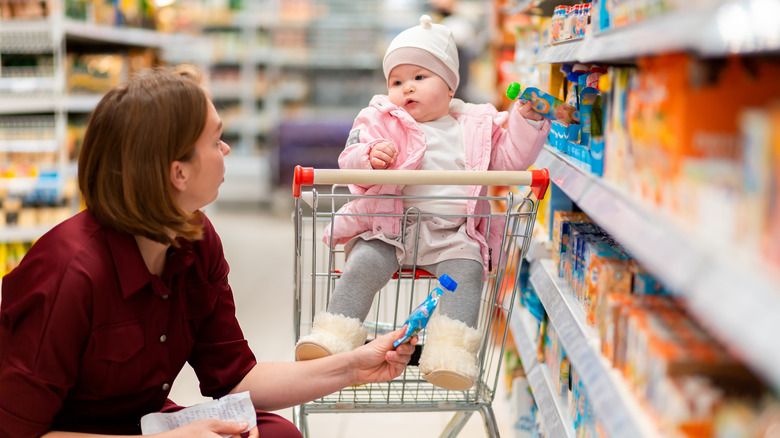How The FDA Is Cracking Down On Lead Contaminants In Baby Food
If you cringed when you read that Consumer Reports found lead in dark chocolate sold at Trader Joe's or that Hershey is facing a federal lawsuit over lead concerns in its chocolate, you're not alone. Lead is a heavy metal (via Centers for Disease Control and Prevention) that derives naturally from the Earth's crust and is found throughout the environment, including in the air we breathe, the water we drink, and the soil in which we grow our food, according to the U.S. Environmental Protection Agency. Although lead has benefits, it is a known toxin for humans even at low levels of exposure, per the World Health Organization (WHO).
The level considered tolerable without adverse consequence depends upon various factors, including how old one is when exposed, with children being particularly vulnerable, as the U.S. Food and Drug Administration (FDA) states in its introductory materials for its program aimed at limiting "consumer exposure to lead" and other contaminants. That program has been ongoing since the mid-1980s, FDA Commissioner Robert M. Califf, M.D. stated in an FDA press release dated January 24, 2023.
The FDA's Closer to Zero program is aimed specifically at cracking down on childhood exposure to lead and other heavy metal contaminants while still "ensuring availability of nutritious foods." As part of the Closer to Zero program, the FDA announced via the above-mentioned press release that it has now published "draft guidance" for "action levels" with respect to lead in foods marketed as baby food. Here is what that means, starting with what these terms actually refer to.
What it means that the FDA has issued draft guidance on lead action levels
"Action levels" refers to how much of any contaminant (in this case, lead) that foods may legally contain, per a general FDA guidance document. When and if action levels become formally adopted by the FDA in accordance with the Code of Federal Regulations, foods that contain more than the stated action level will be deemed "adulterated" by the FDA. Adulterated foods are illegal, and the FDA has the right to take all necessary action to remove adulterated food from the consumer market.
The term "draft guidance" refers to a draft version of recommendations that the FDA has created for the purpose of soliciting comments on the topic from members of the public. In this case, the FDA's draft guidance was created to get comments from stakeholders in the baby food industry by March 27, 2023. The FDA's draft guidance is neither binding on makers of baby food, nor is it intended to serve as advice for consumers about what they should and should not purchase or what they should and should not feed their children, according to the FDA press release.
Putting this all together, the FDA has made a studied determination on how much lead baby food may contain before it is considered unsafe for consumption. On January 24, the FDA officially submitted its draft guidance for public review and comment. Here is what the FDA is recommending.
The FDA's recommendations for limitations on lead in baby food
Babies and children are particularly vulnerable to the effects of exposure to lead, according to WHO. High levels can kill, but even low levels can cause irreversible damage to tiny brains, blood, kidneys, reproductive organs, and more. WHO states there is no such thing as a safe level of lead exposure in children. Nevertheless, the FDA has had to balance that concern with the availability of food for babies and young children in general. Accordingly, the FDA has proposed significantly reduced action levels for lead in baby food and submitted its proposal to the baby food industry, as well as the general public, according to an FDA press release dated January 24, 2023.
The FDA's proposed action levels would apply to all processed foods in all manner of packaging intended for babies and young children under the age of two. Specifically, the FDA seeks to limit lead contamination to 10 parts per billion in fruits, most vegetable mixtures, grains and meat-based mixtures, yogurt, custards, puddings, and single-ingredient meats; and 20 parts per billion for dry cereals and single-ingredient vegetable root vegetables.
Parts per billion measures the concentration of a contaminant in a given food, according to Green Facts. If the FDA's draft guidance is adopted into law, the result could be "as much as a 24–27% reduction in exposure to lead from these foods," according to FDA Commissioner Robert M. Califf, M.D., according to the FDA press release.


